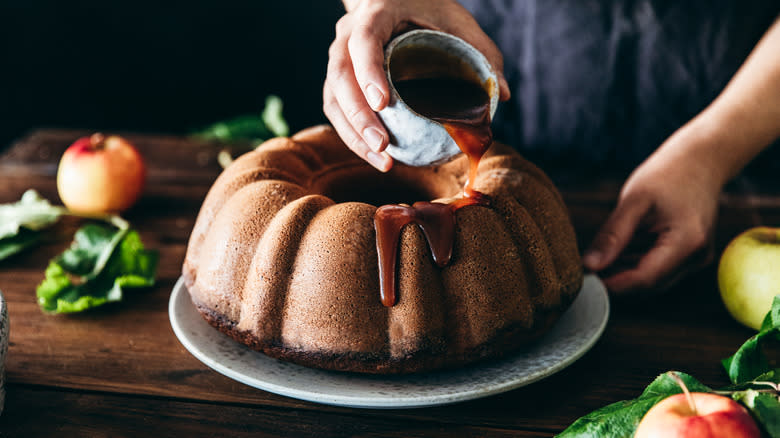What Kind Of Cake Is Gâteau De Sirop And What Does It Taste Like?

When exploring the realm of famous regional desserts in America, Louisiana often brings to mind the iconic New Orleans beignet. However, limiting your Louisiana dessert experience to these French-influenced fritters means you'll miss out on a hidden gem: the wildly underrated Gâteau de Sirop, a Cajun syrup cake.
While the beignet has a rightful claim to fame, Gâteau de Sirop is still a must-try dessert, offering a unique twist on how syrup is usually used in cake. Unlike the conventional practice of soaking a cake in syrup for added softness, this Louisiana country cooking specialty integrates the syrup directly into the batter. The star ingredient is rich and flavorful sugar cane syrup, which imparts a decadent sweetness and creates a moist, dense texture that elevates this cake to a whole new level. Gâteau de Sirop is a culinary delight for lovers of rustic Southern recipes, showcasing Cajun cuisine's mastery of simple but timelessly comforting dishes that draw on local ingredients.
Read more: Cake Hacks Every Baker Will Wish They Knew Sooner
What Goes Into Gâteau De Sirop

As far as cake recipes go, Gâteau de Sirop has a pretty standard list of ingredients, most of which you can probably already find in your pantry. Starting with flour, baking soda, eggs, and milk, most recipes for Gâteau de Sirop use vegetable shortening or oil instead of butter for a source of fat. The cake is usually flavored with traditional warming spices like the ones you'd find in pumpkin pie, which often includes cinnamon accompanied by ground ginger and/or nutmeg. The main sweetening ingredient is, of course, 100% pure cane syrup. While you can use any kind of cane syrup you have on hand, a great deal of Gâteau de Sirop recipes recommend Steen's pure cane syrup by name, perhaps because of its long and iconic history as one of the biggest brands of cane syrup in Louisiana.
Cane syrup, made by boiling down raw sugar cane juice, gives Gâteau de Sirop a distinctly rich flavor with undertones of butterscotch, caramel, and molasses, which pairs exceedingly well with the warm spices for an indulgent mix of flavors. This comforting flavor profile works with the moist and dense texture to make Gâteau de Sirop an unforgettable comfort food experience that can be enjoyed on its own, accompanied by a glaze or frosting, and/or paired with tea or coffee.
Why Is It Called Gâteau De Sirop?

French speakers may notice that the name Gâteau de Sirop, while not technically incorrect, sounds quite odd. The preposition "de" is normally used for foods that feature an irreplaceable ingredient that forms the majority of the dish itself. For instance, orange juice is called "jus d'orange" because there wouldn't be juice at all without the orange. Dishes like cakes, which incorporate multiple different ingredients with one or two defining flavors, would use "à" or "au" instead, as is the case with something like "gâteau au chocolat," meaning chocolate cake in French. To a standard French speaker, "Gâteau de Sirop" may imply a cake made entirely of syrup.
This little grammatical quirk is entirely unique to this Louisiana specialty, and distinguishes it from other French cakes involving syrup. Searching for the more grammatically conventional name "gâteau au sirop" online turns up many results for a Quebecois syrup cake. Sometimes called gateau à l'érable, meaning "maple cake," Quebec's gâteau au sirop features the abundant maple syrup in the area as the "sirop." The French-American culture in Louisiana and the French-Canadian Cajun culture in Quebec both originated from the same 17th century French colony, Acadia, soit's interesting to note that both areas independently created a syrup cake featuring a locally abundant sweetener as a main ingredient.
Read the original article on Daily Meal.

